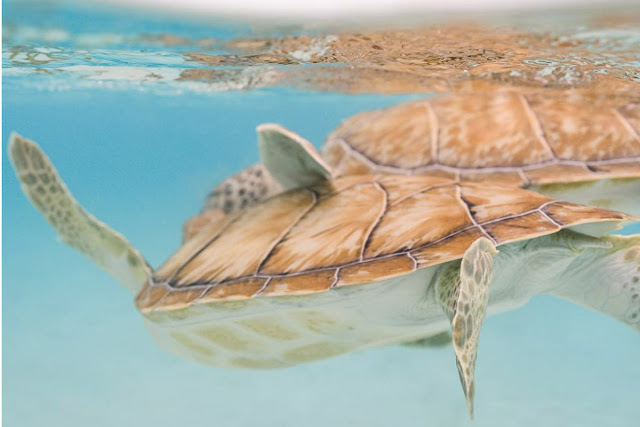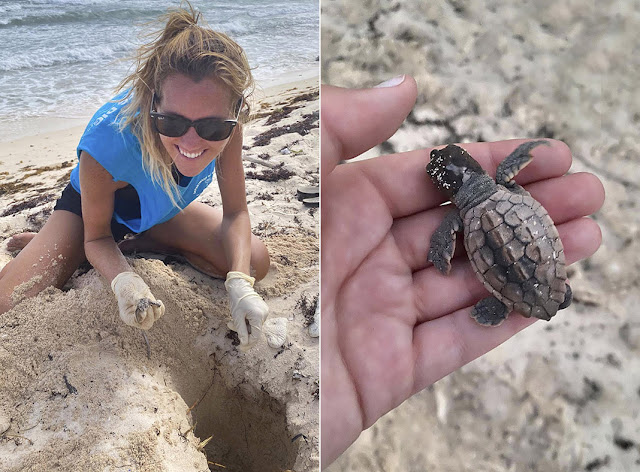This time of year is the time for turtle love!!
To begin this post all of us at Silver Sands love, respect and wish all of Cayman's turtles lots of luck on their journey of being sea turtles in the big blue sea. It is a tough out there! Luckily the Silver Sands beach is on the quiet north end of 7-Mile and we have a HUGE stretch of beach that the turtles seem to LOVE. Every year we have dozens of nests and seeing turtles mating in the waters out front and witnessing mama turtles laying their eggs at night is not a rare sight. We work with the DoE to help monitor this nesting process and in case you ever see any turtles nesting or in need below is the info you can use to contact the Cayman Islands Department of Environment.
Turtle Hotline: 938-NEST (938-6378)
"Sea turtles are charismatic endangered animals that have roamed the seas and nested on our shores for millions of years. A healthy wild sea turtle population can provide unforgettable experiences to Cayman Islands residents and visitors by allowing observation of turtle tracks and nests on our beaches, juvenile turtles in our waters, and baby turtles emerging from the sand and scurrying into the sea."




"Historically, four sea turtle species were found in the Cayman Islands: green (Chelonia mydas), loggerhead (Caretta caretta), hawksbill (Eretmochelys imbricata) and leatherback (Dermochelys coriacea) turtles. Green turtle nesting populations are believed to have been the largest in the Atlantic (numbering in the many millions), and the other species were also abundant. After discovery, commercial harvesting by visiting ships led to a massive reduction and by the mid-1900s our sea turtle populations were thought to be extinct.
Since 1998, the DoE has been conducting a systematic survey of the beaches of the Cayman Islands to identify signs of turtle nesting. The first years of monitoring showed that leatherback nesting was indeed locally extinct, and likely lost to us forever, but extremely small numbers of green, loggerhead, and hawksbill turtles persisted. Since that time, hawksbill nesting has continued to hover at the edge of extinction but loggerhead and particularly green turtle populations have begun to show signs of recovery – increasing from less than 50 nests in the early years of monitoring to more than 600 nests in 2017. However, this represents the number of nests for all species and all islands combined, and each turtle lays multiple nests per season. Therefore the number of individual female turtles in the population is still extremely small, and each one is important to the population’s possible continued recovery."

"While sea turtles spend the majority of their lives in the ocean, from May to November female turtles make their way on shore to lay their eggs. On the beach, nesting turtles, turtle nests and baby turtles are extremely vulnerable."
"The nesting process takes about 1-2 hours and then the female turtle returns to the water, leaving a distinctive track on the beach."
"Turtle tracks are usually about 2 to 3 feet wide and
resemble vehicle tire marks. The center of the track is flat from the smooth
bottom shell of the turtle and flipper markings are present on either side. Once
the turtle has laid her eggs she will cover them with sand before returning to
the ocean. Nests are usually near vegetation, though they are sometimes on
the open beach. Large holes in the sand or signs of disturbed vegetation such
as sand thrown on bushes may suggest nesting. All signs of nesting should be
reported to the Department of Environment and nests left undisturbed."

"In recent years, a dramatic increase in sea turtle nesting numbers has been observed. However, as more nesting now occurs on developed beaches, threats to turtles have also increased, making the continued recovery and survival of nesting sea turtles in the Cayman Islands uncertain."
The threats that the DoE are referring to development along the beach bring with it more bright lights, more disruptive humans, more noise, more obstacles and everything else that comes with development. The above turtle got so turned around she ended up in a dead end between graves at Cemetery Beach in West Bay. Luckily Amanda, of the many turtle monitoring volunteers that walk the beach in the morning looking for fresh tracks, found this lost girl and she was safely redirected back to the sea.





"After about fifty to sixty days, baby turtles (called “hatchlings”) will emerge from the sand and will scurry down to the sea. With luck, after 15-20 years or more they will return to breed and replenish our populations."
"Artificial lighting is another major threat to our turtles. Every year, artificial lights near the beach misorient hatchlings – leading them away from the sea where they are killed by dehydration, exhaustion, or vehicles. Fortunately, there is a win-win solution for beachfront residents and turtles: cost-effective, efficient ‘turtle friendly’ lighting can be implemented in order to drastically reduce misorientation of hatchling turtles, increase nesting, and promote low season ecotourism."
Silver Sands is a great example of the switch from bright turtle confusing lights, to a turtle friendly option. We have so many nests on our beach each year we felt the switch was important to the survival of all the Silver Sands hatchlings!

























Nice Post!! outdoor
ReplyDelete